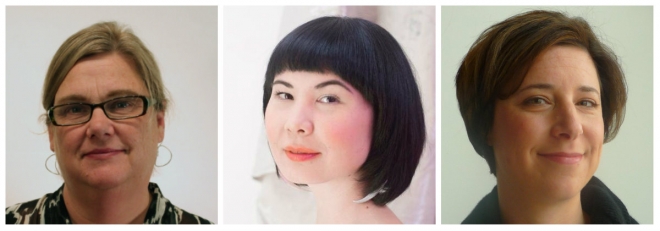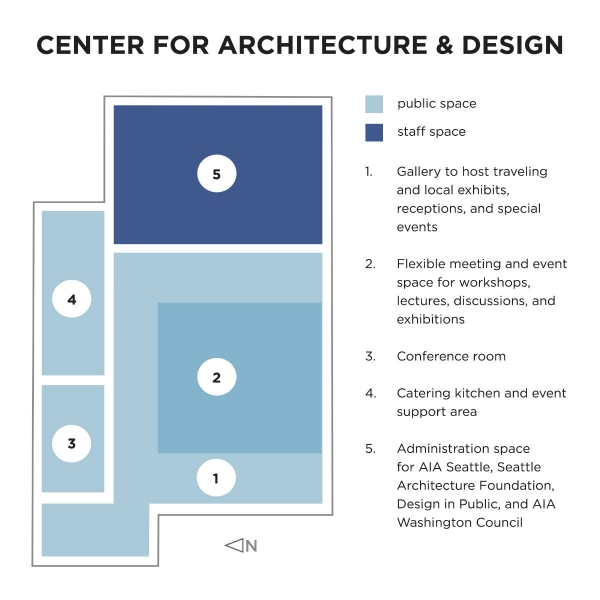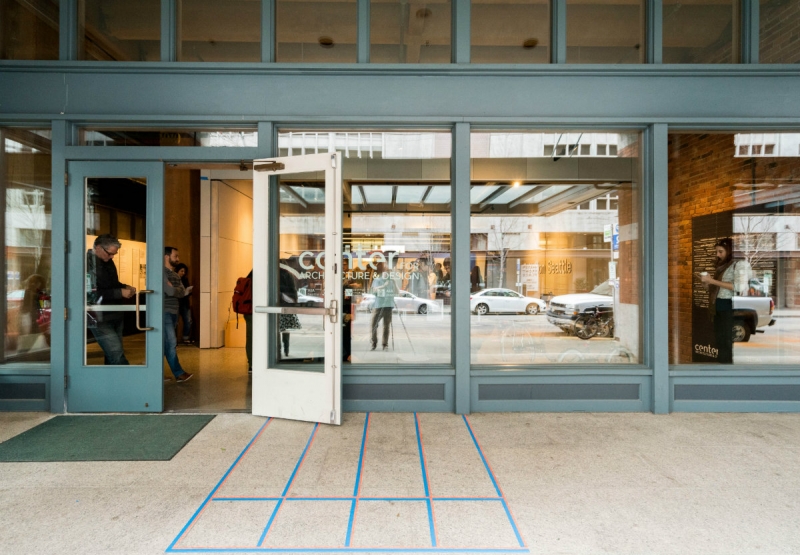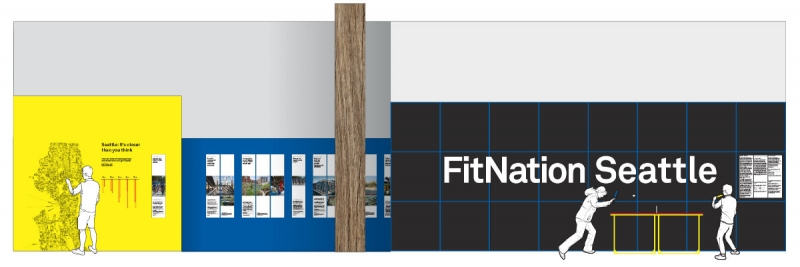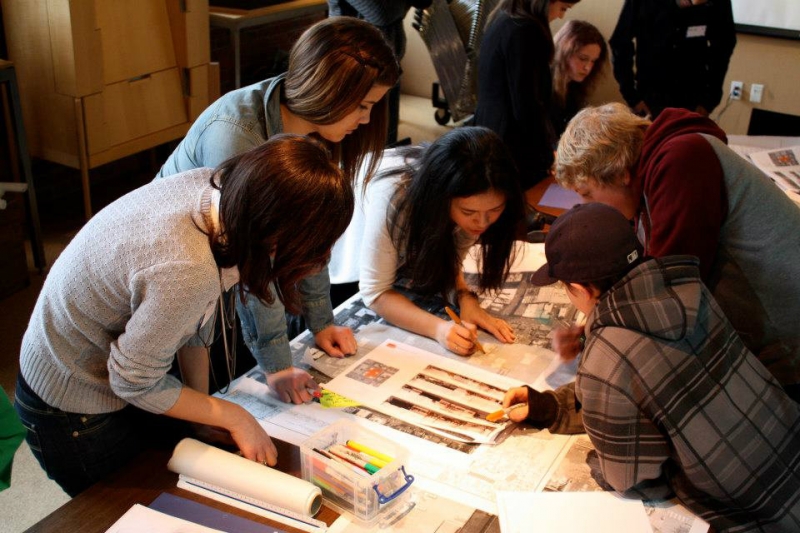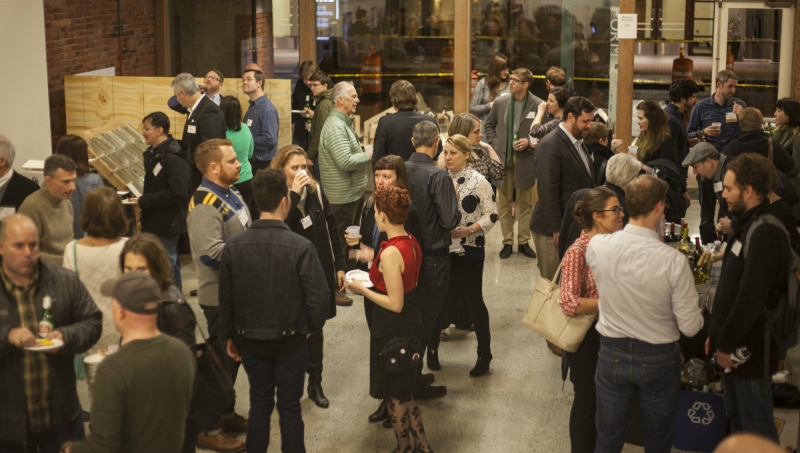Left to right: Lisa Richmond, S. Surface, and Stacy Segal
The Center for Architecture & Design in Seattle celebrated its grand opening on March 5, 2016. CfAD brings into one shared space AIA Seattle, Design in Public, Seattle Architecture Foundation and AIA Washington Council. AAO interviewed the lead collaborators on fundraising for an architecture center, structuring partnerships, planning for long-term impact, and more.
1) Congratulations on opening the new Center for Architecture and Design (CfAD) in Seattle. To provide background for our readers, please describe the build-out and the setting of the 4,500-square-foot space at 1010 Western Avenue.
Lisa Richmond, AIA Seattle
The Center for Architecture & Design is a 4,500 square foot space in downtown Seattle, just a block from our central waterfront. The Center occupies the ground floor of the landmarked National Building, and the design retains many of the building’s original features, including old growth timber columns and brick walls. The Center includes a large, flexible multi-purpose space for exhibits and events, a smaller meeting room, catering facilities, and staff workspace for 18.
2) CfAD houses four organizations: AIA Seattle, Design in Public, Seattle Architecture Foundation and AIA | Washington Council. How will being together in one space change the nature of your collaborations? Will there be a shared mission, joint strategic planning and staff sharing, or will the entities remain entirely independent?
S. Surface, Design in Public
Each organization performs its basic functions and missions separately. We all have distinct missions: AIA Seattle and AIA Washington State are membership organizations that serve the profession. Seattle Architecture Foundation has a focus on education around the history and physicality of Seattle’s built environments, with a particular emphasis on youth/family programs and tours. Design in Public is multi-disciplinary and reaches a broad, general public audience as well as designers in multiple fields - so not only architects, but also product, graphic, fashion, ui/ux, landscape, and other types of designers.
To keep things running in the Center, the organizations have a shared programming committee consisting of all our executive directors, program staff, and gallery managers. We set broad bimonthly themes for CfAD programming that align with the rotating exhibitions in our gallery - or in September/October, with the Seattle Design Festival theme. Center activities are not all strictly bound to the themes, but we all work together to create programs around each theme. This helps us all plan further ahead and avoid accidentally overlapping events that might draw the same audience.
The four organizations share a calendar to help us organize meetings and events, and we have a monthly all-CfAD staff meeting. We share a rotating housekeeping schedule to make sure that work is divided fairly. There are some staff overlaps between AIA Seattle and Design in Public, which is an initiative of AIA Seattle. The weekday receptionist position is split between one employee from AIA Seattle and one from Seattle Architecture Foundation; each receptionist also has an additional managerial role within their own organization. There is a third, shared Saturday-only receptionist for the gallery. Finally, several of AIA Seattle and Seattle Architecture Foundation’s staff (as well as some former staff who have changed jobs) also volunteer after-hours with Design in Public to help coordinate the Seattle Design Festival!
Lisa Richmond, AIA Seattle
Because we will continue to operate as four separate organizations, we have agreed to cluster our programming thematically. Each two-month theme focuses on a topic or issue that is compelling and relevant to our public audience; upcoming themes include housing affordability, design for a rapidly changing city, and universal design. Each of our partner organizations then focuses programming on that theme, through exhibits, presentations, hack-a-thons and charrettes, competitions, tours, family workshops, etc. So far, this thematic approach has proven to be an excellent vehicle for collaboration. It’s also given us the opportunity to hire a publicist to promote the work for the Center in general, the messaging around each theme, and the programs of each of our organizations individually.
3) With the new dedicated gallery space, tell us about plans for upcoming exhibitions.
S. Surface, Design in Public + Lisa Richmond, AIA Seattle
Currently, AIA Seattle has adapted Fit Nation from the Center for Architecture in NYC. The exhibit showcases both national and local highlights of active design that range from gigantic urban parks, to transit plans, to wearable technology, and of course individual buildings. We worked with a local exhibit design firm, Studio Mathews, to add lots of fun interactives to the exhibit. Visitors can listen to nature sounds, plot out walking distances on a giant city map, reveal active design data on a working treadmill, or leave their own ideas for a more active city.
Coming up in April is Living Small, an exploration of small urban living environments in Tokyo, Copenhagen, and New York. The exhibit seeks inspiration for new housing options for our city, which is experiencing extremely rapid growth and a significant housing shortage.
Opening at the end of June, Seattle Architecture Foundation and Design in Public are co-curating an exhibition, Changing Seattle. It locates the current tech/real estate development booms within the legacy of settler-colonialism and gold rush era frontierism in the Pacific Northwest, and proposes a commitment to history and memory as integral to innovation.
In September/October, during the Seattle Design Festival, the Seattle Architecture Foundation will host its annual Model Show, where practitioners and students around the region exhibit models and projects designed in the past year.
Closing out 2016, Design in Public is adapting the Miami Center for Architecture and Design’s Listen To This Building exhibit. We’ll incorporate local examples of design for the blind and address accessibility/disability broadly, through highlighting multisensory ways of experiencing works of design: sound, time, scent, texture, temperature, taste, incline, aura.
4) Seattle is one of the fastest growing US metros. What are some of the biggest design needs facing the city? Will any be a focus of CfAD programming in 2016?
S. Surface, Design in Public
All of us have programs that address the city’s most pressing design concerns. Housing, urban density, infrastructure, transportation, sustainability, disaster relief, homelessness, gender, race, education, youth, materials innovation, the economy, globalization, public health… you name it, one or more of the CfAD organizations is offering programming related to it.
Lisa Richmond, AIA Seattle
Seattle is growing so fast, and that growth creates all kinds of opportunities for design, as well as some significant pressures on our city. Each of our organizations addresses current issues in a different way -- AIA through advocacy, research and professional dialogue, SAF through community conversations and family programming, DiP through expansive pan-design programming. For example, housing and homelessness have reached a level of crisis in our city; our Mayor has declared a state of emergency around homelessness, and everyone in the city is grappling with the impacts of development and rising housing costs. During our two months of housing programming, AIA will be producing the exhibit Living Small, and hosting a conference on urban housing. We will also be working at the legislative level on things like changes to land use codes, funding for affordable housing, and design solutions for temporary shelter. SAF has planned several youth and family programs about housing and neighborhood design, as well as public lectures that look at housing design and regionalism. And DiP will be exploring housing at the scale of the individual, with a program called Closeness.
5) You've embarked on a $1.25 million campaign to support the new space and programs. How is the fundraising going? What new insights have you learned about communicating your message/impact?
Stacy Segal, Seattle Architecture Foundation
We’ve completed our campaign and exceeded our goals for cash and in-kind giving! It was critical for us to understand how to leverage resources and contributions from our design community. Seattle was extremely supportive of this project and clearly understood the importance of establishing a Center like what we’ve created. Take time before your campaign to understand the various motivations for giving – for many, it was viewed as an incredible marketing opportunity, but, for others, it was more philanthropic.
Our messaging was geared towards what is happening locally – Seattle is going through a boom time with record numbers of newcomers moving into our city and there are serious challenges around managing this rapid growth and creating a future city that is thoughtfully designed. In our case, it was important for us to talk about how our space would provide a forum for conversations about our city’s future and a place for leaders and the public to connect with each other and be heard. It was also important to have a place that would inspire future leaders and the general public to get involved in shaping our city's future.
Lisa Richmond, AIA Seattle
We’ve completed our campaign in about 10 months, and exceeded our goal. In total, we’ve raised around $2 million in cash and in-kind donations, to cover both construction and a program endowment. We were so successful simply because the concept of a Center sold itself. Generally, the reaction was, “of course you are doing this” or “what took you so long?” Our community was ready and waiting.
6) What's been the immediate reaction to CfAD? What impact do you hope to see in 10 or 20 years?
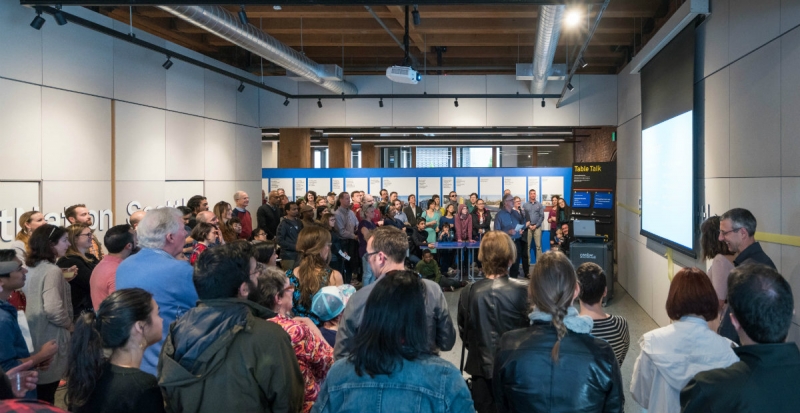
Stacy Segal, Seattle Architecture Foundation
The immediate reaction has been incredibly positive and has exceeded our expectations on many levels. For SAF, all of our events have been very well attended and there is renewed energy among our volunteers, board and donor base. I would expect in 10-20 years we will have outgrown our space and will be looking for opportunities to expand. The possibilities are endless, but I envision a much larger space, possibly with additional community partners, where we can host more than one exhibit at a time and offer a wider range of cultural arts programs.
In terms of broad impact, I hope we are able to demonstrate how our Center is educating people to make different decisions about architecture, design and development in our City. I'd also like to see that we are able to encourage more people to get more engaged in neighborhood groups and other city planning meetings where they can be part of the decision-making process. And finally, I hope we can inspire young people to explore architecture, engineering and the various design disciplines as career options.
S. Surface, Design in Public
The reaction has been overwhelmingly positive. We have had visitors intentionally seeking us out and also randomly wandering in off the street from our first day open, which has been really fun to experience. We hear a lot of, “I can’t believe we didn’t have a place like this before,” and even more, “It’s about time!” In 10 or 20 years (or 1 or 2 or 5), I’d like to see us established as a community anchor while still keeping the dialogue fresh. The Center should be the first place people seek to get involved with Seattle design. I hope that in addition to being a hub for Seattle’s design scene, the Center will contribute to the discursive currents around design.
7) In one sentence, what’s the biggest opportunity/advantage for your organization joining the CfAD?
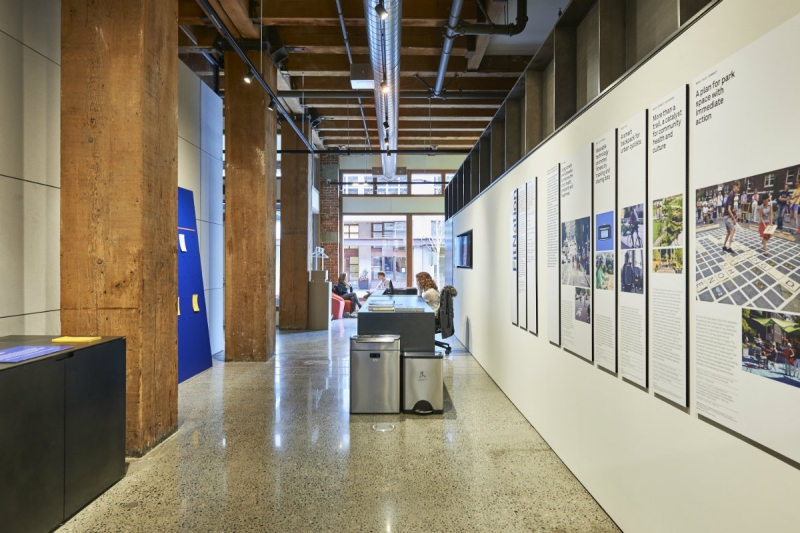
Stacy Segal, Seattle Architecture Foundation
The opportunity to be in more visible location that reflects thoughtful design and presents opportunities for growth and collaboration has been an enormous benefit so far.
S. Surface, Design in Public
The gallery/event space has transformed the capacity and reach of Design in Public. Whereas previously we focused on events - the annual Seattle Design Festival and episodic competitions - we now also have a place where we can create original content for exhibitions, host year-round events, and maintain an ongoing public presence. There’s more opportunity for our board, volunteers, and community to contribute. While we have always shared an office with AIA Seattle, it is also quite helpful to sit by SAF and AIA Washington Council, with whom we often collaborate.
8) What advice would you offer to others who are considering opening an architecture center in their own cities?
S. Surface, Design in Public
Lisa and Stacy can address the logistics so I will simply advise everyone to be as measured, thoughtful, and conscientious as they have been. They, alongside our Boards, sought to ensure that we opened at the right time, when Seattle was more than ready for this type of space to succeed. They worked tirelessly to develop it as an example of high-quality design made in an environmentally and financially responsible process. The Center is clearly here for the long haul, and is a true community effort thanks to our exemplary leadership. (More simply, the best advice I could give is: hire Stacy and Lisa as consultants before you open an architecture center.)
Lisa Richmond, AIA Seattle
We worked hard to balance ambition with capacity. We didn’t want to come out of the project with a facility we couldn’t afford or maintain. At the same time, we didn’t want to undersell the concept and find we did not have enough space. I think we hit the sweet spot, but time will tell.
One specific piece of advice I have is to hire professional support for media outreach. We hired a publicist to help us with our grand opening, but she’s staying with us throughout the year to promote Center programs and themes. The huge uptick in media coverage, and the resulting expansion of our audience, has made that an exceedingly good investment.
Stacy Segal, Seattle Architecture Foundation
Make sure you have strong reach in the community, an engaged board or leaders and history of public programming prior to attempting to create a public space. I think it is also important to have an audience beyond AIA members who will be embrace the idea of a Center.
If you are engaging in a fundraising campaign, take time to fully understand your capacity -- what can you raise, and then plan to raise enough to not only build the space but enough so that you have funds for new programs and activities. If you do not have a history of securing sponsorships and annual support, it will be beneficial to engage the services of a fundraising consultant or other professional who can help you assess your capacity and make sure you have the resources you need to be successful.
Utilizing the leadership and connections of volunteers was crucial to the success of our campaign. Our Boards were involved with fundraising but we also established a Campaign Cabinet comprised of strong supporters and community leaders who led our fundraising efforts. We also established other committees who provided project oversight. And finally, because we were completing this project on a relatively quick timeline, it was necessary for our Boards to authorize a decision-making team who could move things forward without having to seek full approval from all Boards.
It is easy to get caught up in the idea that everything can be provided in-kind. While we clearly benefited from a wide range of in-kind services and materials which allowed us to complete our project, the process can be challenging and time consuming to manage and it is necessary to also raise enough cash to fund your project.

